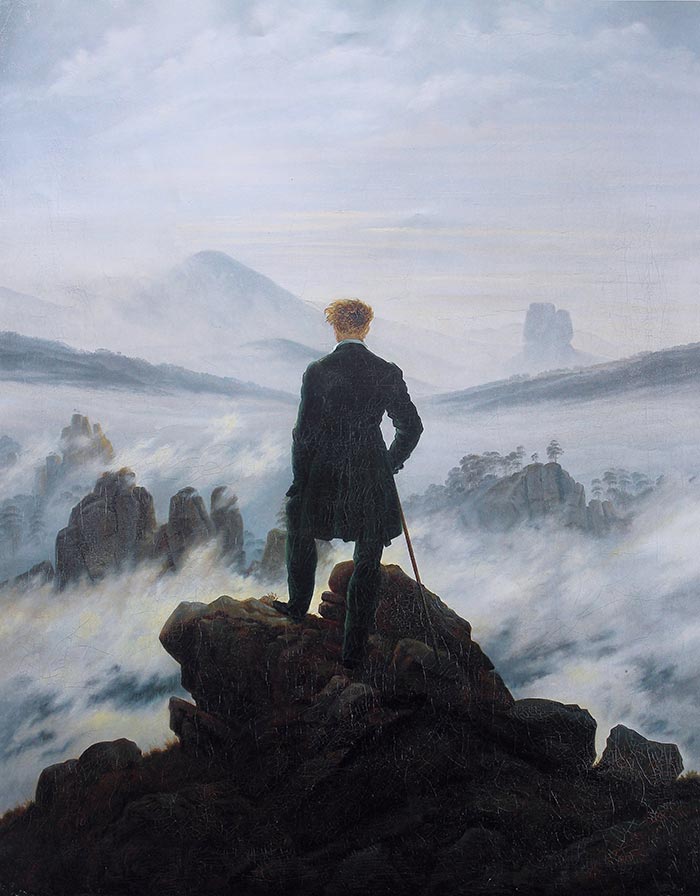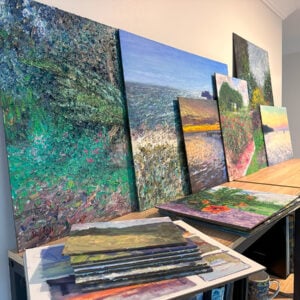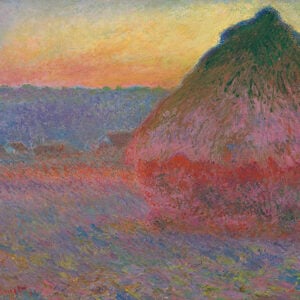In this post, I take a closer look at Wanderer Above the Sea of Fog by Caspar David Friedrich. It is an iconic work of Romanticism that features a man standing on the edge of the rocky terrain, looking out over the foggy landscape. I cover:
- Key Facts and Ideas
- Color and Light
- Composition
- Edges
- Key Takeaways
- Want to Learn More?
- Thanks for Reading!

(Before diving into this post, make sure to pick up a copy of my free Landscape Painting Starter Kit.)
Key Facts and Ideas
- It is also referred to as Wanderer Above the Mist or Mountaineer in a Misty Landscape.
- The identity of the man is uncertain. Some have suggested it is a self-portrait of the artist himself, pointing to similarities in appearance, such as the red hair. Historian Joseph Koerner provides a more likely interpretation that it is a certain individual, Colonel Friedrich Gotthard von Brincken. In his book, Caspar David Friedrich and the Subject of Landscape, he writes:
“Von Brincken was probably killed in action in 1813 or 1814, which would make the 1818 Wanderer Above the Sea of Fog a patriotic epitaph”. Via Sothebys
- The landscape is based on the Elbe Sandstone Mountains in Saxony and Bohemia. It is not an exact depiction of the landscape, rather an amalgamation of various parts. Friedrich would travel the mountains and create sketches. Then, back in the studio, he would construct his own interpretation of the landscape.
- It is considered an iconic work of Romanticism, which is characterized by a deep appreciation of nature.
Color and Light
The sun is the primary light source. The silhouette of the foreground suggests it is overhead and out in front.
The clouds and fog seem to be diffusing the light, meaning it is not a strong and direct light like the midday sun on a clear day. This is considered to be a “good” light to paint under, as it provides enough light for you to clearly see all the colors, but not so much as to wash the colors out. (I provide a cheat sheet on how to paint under different types of light in my Landscape Painting Starter Kit).
The colors are restrained, with mostly weak blues, pinks, and yellows. The painting relies much more on value contrast (the contrast between light and dark elements) than hue or saturation contrast. Refer to the grayscale image of the painting below.

As you can see, there is a sharp contrast between light and dark elements. This is because most of the colors are at the extremes of the value scale (the colors are either really light or really dark; there are hardly any mid-tones).
Notice how the darks represent the man, rocks, and other “solid” objects; whilst the lights represent the clouds, sky, and fog. So not only is there a contrast between light and dark, but also between solid and transient.
The values in the painting also get gradually lighter as you recede into the distance, starting with the dark, imposing rocks in the foreground, and ending with the barely visible mountains in the background. The colors also get a touch cooler in temperature. This creates a sense of atmospheric perspective or depth.

Composition
Unlike most landscape paintings, Wanderer Above the Sea of Fog has portrait dimensions (taller than it is wide). This reiterates the upright stance of the man around the center.
The stance of the man is an important feature of the painting in and of itself. He is leaning primarily on one leg and there is a slight shift in his body to counter this. This is known as contrapposto, which is Italian for “opposite” or “counter”. It is considered a natural and visually pleasing stance (think about what the painting would look like if he was standing straight and rigid).

Most of the painting is taken up by negative space (sky, clouds, and fog). But, there is a sense of balance against the small but powerful areas of positive space (rocks, trees, and man).
Another interesting observation is the open plane of the composition. Other than the foreground at the bottom, there is no use of framing. This helps convey the vastness of the landscape.
Edges
In this painting, hard edges are used for the rocks in the foreground and the man. This gives a sense of clarity and closeness. Much softer edges are used for the transient fog, clouds, and sky.
Notice how all the edges get softer as you recede into the distance, yet the relationships stay intact. By relationships, I mean how hard one edge is compared to another.
For example, if you look at the foreground, the edges used for the rocks are harder than the edges used for the fog.
Now, look at the distant mountains. In general, this area is much softer than the foreground. But, the relationships are the same-the edges of the mountains are harder than the fog, clouds, and sky.
The key point here is that relationships matter, much more than the absolute hardness of an edge.
I also draw your attention to the different techniques Friedrich used to alter the hardness of the edges.
One technique is gently blending one color into the next. This softens the edge between two color shapes. The more the colors are blended, the softer the edge.
The other technique relies on the use of contrast, in particular, color contrast. The idea is this: the sharper the contrast between two shapes, the harder the edge. For example, take the following two shapes:

The contrast is sharp and the edge is hard. Watch what happens if I reduce the color contrast between the two shapes.

The transition between the two colors is just as abrupt, but the edge appears much softer.
Below are two more examples using colors from the painting. The first with colors from the foreground-a sharper contrast and a harder edge. The second with colors from the background-a weaker contrast and a softer edge.


Key Takeaways
- You are not limited to painting only what you see. You can always mix and match different parts to create your own unique composition like Friedrich did in this painting.
- The perspective of the painting has a powerful influence on the focal point. Despite the man being positioned center stage in this painting, the main focus appears to be the vast landscape. We get a chance to see what the man is seeing.
- The light on an overcast day is “good” light to paint under, as it tends to be diffused and balanced.
- You can use color gradations to give a sense of atmospheric perspective.
- A large area of “quiet” negative space can be balanced against a small area of “active” positive space.
- Edge relationships matter, much more than the absolute hardness of the edges.
Want to Learn More?
You might be interested in my Painting Academy course. I’ll walk you through the time-tested fundamentals of painting. It’s perfect for absolute beginner to intermediate painters.
Thanks for Reading!
I appreciate you taking the time to read this post and I hope you found it helpful. Feel free to share it with friends.
Happy painting!
Dan Scott

Draw Paint Academy







Excellent, really helpful. Thanks
Very interesting and informative. Thank you
Great article Dan. Very informative and thought provoking
Thank you
Thanks ever so much for all your valuable hits. I genuinely appreciate it.
You are always worth reading. You make me think. Thank you.
This is a particularly helpful and interesting post. Many points to follow up and practice. Thank you
I always look forward to your emails and tips. Credit information and I learn from it every time.
This overview, like so many of your pointers, takes me a long way toward understanding what my own paintings are about. There is so much yet to know if I want to create a good painting intentionally. It makes me appreciate it very much to discover I occasionally succeed accidentally. Thanks so very much for helping us all along!
Very helpful and insightful!
So much important information here. Thank you for sharing.
Thanks for the lesson on contrapposto.
This really made me go back and study the painting. I hope I can make use of the valuable information.
You draw my attention to so many different elements and explain them so simply. Thank you.
Wow! I am learning so much and gaining enthusiasm for art! Thank you so much!
Great analysis. I enjoyed…..and learned a lot. Thank you for sharing.
Thank you, Dan, for your inspirational analysis of this painting. I have been grappling with inserting a human figure in the foreground of a snowy winter landscape. I now see a way through to doing it!
I have never seen this painting before but you made it come alive for me. Thank you for the analysis and the painting tips.
Dan, sempre fico esperando seus e-mails sobre as análises de pinturas. Gostaria que você fizesse uma análise de uma pintura de Vermeer.
Obrigado
Really appreciate the takeaways.
Dan thanks for pointing out how to compose and look at the colors. I am not a painter at all but I pay more attention in the real life nature and see what you just brought out.
Very clear and concise! Thank you for the wonderful post!👍👏🏼
Loved this painting and I have learned from it because of your walking me thru it
Hi Dan,
I like this work, even without the figure it is a nice study in painting scenery. Including my arch nemesis “ROCKS”. Another success story from the Start cott vault.
Thanks, Dave M.😎🇦🇺
Ii appreciate this type of newsletter. It’s different and informative.
Thank you for it!
I love these…you’ve shown things I wouldn’t have noticed.
Very helpful, thank you.
So helpful. Struggling with edges and this explains the technique. Thank you
Valuable insights .
Thank you.
Can’t go over value and contrast too much. Thanks Dan
Thank you for this thoughtful post. I found the discussion of the human pose as integrated into the more dominant landscape very useful!
This beautiful& romantic painting helps set the mood for Valentine’s Day this upcoming Friday. Thanks!
Thank you once again.
That was really nice, thank you! I would just add that this genre of painting used the landscape as a symbol for spiritualism and added elements of Greek and Roman influence. That specific contraposto stance symbolized virtue and extreme spirituality during the Renaissance.
Hi
As I have never formally studied art I am finding your analyses of art fascinating.
Thanks heaps!
Thank you so much for this post! It was really well written and helpful for studying this painting.